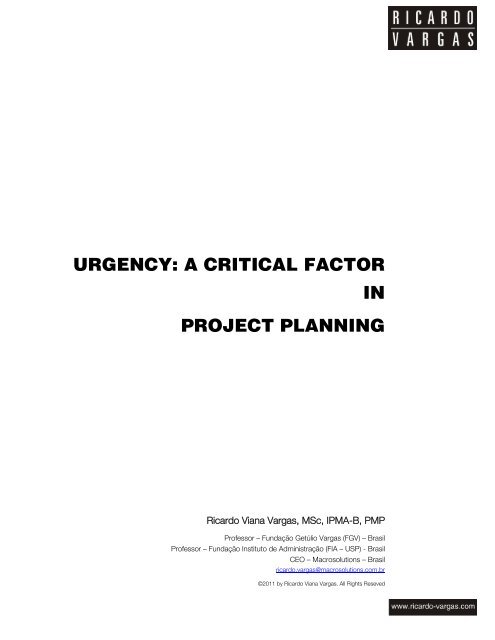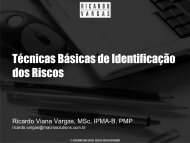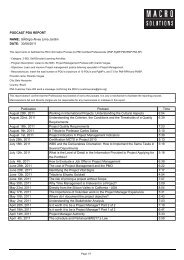urgency: a critical factor in project planning - Ricardo Vargas
urgency: a critical factor in project planning - Ricardo Vargas
urgency: a critical factor in project planning - Ricardo Vargas
Create successful ePaper yourself
Turn your PDF publications into a flip-book with our unique Google optimized e-Paper software.
URGENCY: A CRITICAL FACTOR<br />
IN<br />
PROJECT PLANNING<br />
<strong>Ricardo</strong> Viana <strong>Vargas</strong>, MSc, IPMA-B, PMP<br />
Professor – Fundação Getúlio <strong>Vargas</strong> (FGV) – Brasil<br />
Professor – Fundação Instituto de Adm<strong>in</strong>istração (FIA – USP) - Brasil<br />
CEO – Macrosolutions – Brasil<br />
ricardo.vargas@macrosolutions.com.br<br />
©2011 by <strong>Ricardo</strong> Viana <strong>Vargas</strong>. All Rights Reseved
SUMMARY<br />
Given the natural speed and dynamism of the world, agility and sense of <strong>urgency</strong> has<br />
become preponderant <strong>in</strong> all <strong>project</strong>s. Challeng<strong>in</strong>g deadl<strong>in</strong>es and budget make the<br />
management of these <strong>project</strong>s a risky activity. The more time and cost become<br />
challeng<strong>in</strong>g, the need for a more meticulous and detailed plann<strong>in</strong>g becomes<br />
fundamental. On the other hand, the <strong>urgency</strong> <strong>in</strong> the plann<strong>in</strong>g of these activities often<br />
directly affects the quality of the developed plans.<br />
This article aims to discuss the costs and benefits of speed <strong>in</strong> develop<strong>in</strong>g a <strong>project</strong> plan<br />
and proposes a basic process that consists of 10 steps to plan and 10 steps to track a<br />
<strong>project</strong> <strong>in</strong> a short time. The process aims to simplify and prioritize <strong>critical</strong> documents to<br />
be developed <strong>in</strong> order to ensure the purpose, scope, deadl<strong>in</strong>es and budgets, as well as<br />
direct restrictions of the <strong>project</strong> to be developed.<br />
F<strong>in</strong>ally, the article presents a list of success <strong>factor</strong>s to be observed to handle and quickly<br />
develop effective <strong>project</strong> plans.<br />
URGENCY: THE COSTS AND BENEFITS OF SPEED<br />
A <strong>project</strong> is carried out to produce a beneficial change <strong>in</strong> the environment and it has<br />
three features (TURNER & MÜLLER, 2003):<br />
1. It is unique: there are not equal previous <strong>project</strong>s.<br />
2. It is new: previous <strong>project</strong>s did not use the same approach.<br />
3. It is temporary: it has a beg<strong>in</strong>n<strong>in</strong>g and an end.<br />
These features produce certa<strong>in</strong> pressures, like the sense of <strong>urgency</strong>, the uncerta<strong>in</strong>ty and<br />
the need of <strong>in</strong>tegration. The <strong>urgency</strong> is directly related to the production of results with<strong>in</strong><br />
the shortest time.<br />
Objective Features Pressures<br />
To<br />
deliver<br />
Unique<br />
Uncerta<strong>in</strong>ty<br />
Beneficial<br />
Change<br />
Novel<br />
Integration<br />
Temporary<br />
Urgency<br />
Exhibit 01- Projects’ features (TURNER & MÜLLER, 2003)
Accord<strong>in</strong>g to Betty Sue Flowers (MARCUS, 1998), people must have a sense of <strong>urgency</strong><br />
even when they are fac<strong>in</strong>g a good situation. The sense of <strong>urgency</strong> doesn’t come only<br />
from an emerg<strong>in</strong>g crisis, but also from the need to be ready for any situation, <strong>in</strong>clud<strong>in</strong>g<br />
opportunities.<br />
Given this scenario, it is essential that the <strong>project</strong> manager respond immediately to<br />
requests from customers and from other <strong>in</strong>terested with a legitimate sense of <strong>urgency</strong><br />
(KERNION, 1999). Thus, the challenge becomes balanc<strong>in</strong>g the sense of <strong>urgency</strong> and<br />
pressure with time for reflection, experimentation and <strong>in</strong>novation that a unique product<br />
or service will require to be developed (EPPLER & SUKOWSKI, 2000).<br />
SIMPLIFIED FLOW FOR THE DEVELOPMENT OF PROJECT PLAN<br />
In order to directly attend the need, we need to simplify the management process.<br />
Simplification occurs through careful analysis of the processes that may be deemed<br />
fundamental and essential. Importantly, only the processes considered crucial must be<br />
carried on, s<strong>in</strong>ce we consider the speed of development as a priority, but it does not<br />
mean that other processes that are not listed cannot br<strong>in</strong>g results <strong>in</strong> <strong>project</strong> plann<strong>in</strong>g.<br />
The proposed flow is based on the PMBOK ® Guide (PMI, 2008), highlight<strong>in</strong>g the<br />
sequence of activities that make up the process, start<strong>in</strong>g from a assumption that there is<br />
already an assigned <strong>project</strong> manager. From the detailed processes <strong>in</strong> the guide, we set<br />
up a flow with 10 processes, as highlighted <strong>in</strong> Exhibit 01 and detailed below.
Exhibit 02- Simplified flow for the development of Project Plan<br />
1. Develop Project Charter – This process aims to develop the Project<br />
Charter that documents the bus<strong>in</strong>ess needs that will be attended by the<br />
<strong>project</strong>s, <strong>in</strong> addition to obta<strong>in</strong><strong>in</strong>g the commitment of areas / people<br />
<strong>in</strong>volved and dissem<strong>in</strong>ate the official birth of the <strong>project</strong> to all <strong>in</strong>terested.<br />
The Project Charter should be kept unchanged throughout the <strong>project</strong>. Its<br />
update is done <strong>in</strong> case of extreme change <strong>in</strong> the <strong>project</strong>, for example,<br />
chang<strong>in</strong>g the sponsor or the <strong>project</strong> manager, or a substantial change <strong>in</strong><br />
the budget or schedule. The “urgent” Project Charter should also<br />
<strong>in</strong>corporate some elements that traditionally should be <strong>in</strong> the Scope<br />
Statement. In this case, what is proposed is the development of a s<strong>in</strong>gle<br />
document that br<strong>in</strong>gs together the ma<strong>in</strong> po<strong>in</strong>ts of the Statement of Scope<br />
to the Project Charter.
2. Create the Work Breakdown Structure – Process that aims to develop the<br />
ma<strong>in</strong> tool of design of the <strong>project</strong> scope. The <strong>project</strong> WBS is a hierarchical<br />
structure that presents a visual decomposition of the <strong>project</strong> <strong>in</strong>to smaller,<br />
more manageable parts, called “work packages”. It must be constructed<br />
as "top-down" and detailed <strong>in</strong>itially up <strong>in</strong>to approximately 3 levels. The<br />
other levels will be updated and detailed with the development of <strong>project</strong>s<br />
through roll<strong>in</strong>g waves plann<strong>in</strong>g models (GITHENS, 1998).<br />
Exhibit 03 – Roll<strong>in</strong>g Wave plann<strong>in</strong>g (GITHENS, 1998)<br />
3. Develop Schedule - Process that assigns durations to work packages<br />
(lower level of WBS) and the precedence relationship between these<br />
packages, result<strong>in</strong>g <strong>in</strong> the <strong>project</strong> Network Diagram and Gantt chart. At<br />
this stage, the estimated duration of the <strong>project</strong> is determ<strong>in</strong>ed.<br />
4. Determ<strong>in</strong>e Budget – The objective of this process is develop<strong>in</strong>g the<br />
estimated cost of the <strong>project</strong> works that will consolidate the <strong>project</strong><br />
budget and the basel<strong>in</strong>e costs. The <strong>project</strong> budget should be developed<br />
at the level of detail that is compatible with the actual details of the work<br />
and can / should be ref<strong>in</strong>ed with <strong>project</strong> updates.<br />
5. Develop Responsibility Assignment Matrix – Process that aims to develop<br />
the spreadsheet that def<strong>in</strong>es the responsibilities with<strong>in</strong> the <strong>project</strong>. It lists<br />
the supplies and / or large blocks of WBS with the human resources<br />
responsible for implementation and approval of work, as well as the<br />
stakeholders to be <strong>in</strong>formed and consulted. It is also known as RACI<br />
matrix (ARMSHAW, 2005).<br />
6. Develop Communication Plan – Process that aims to develop a simplified<br />
spreadsheet highlight<strong>in</strong>g who will receive the <strong>in</strong>formation (identified<br />
stakeholders), what is go<strong>in</strong>g to be <strong>in</strong>formed, when communication is<br />
made, where the <strong>in</strong>formation will be collected, the reason why the<br />
communication is be<strong>in</strong>g performed, who is responsible for communication
and how it is done and the cost of production of the <strong>in</strong>formation (5W and<br />
2H).<br />
7. Develop Prelim<strong>in</strong>ary Risk Plan – The objective of this process is to identify<br />
potential <strong>project</strong> risks us<strong>in</strong>g a structured approach to collect and<br />
document the identified risks, such as the Nom<strong>in</strong>al Group Technique<br />
(NGT), Delphi and Bra<strong>in</strong>storm<strong>in</strong>g (ADAMS & MEANS, 2006). It is<br />
suggested that only threats are identified, rul<strong>in</strong>g out opportunities for the<br />
process to be developed faster. Then, the identified risks are analyzed <strong>in</strong><br />
terms of probability, impact and <strong>urgency</strong>, allow<strong>in</strong>g that action plans can<br />
be developed <strong>in</strong> response to major risks. The risk plan will be updated<br />
throughout the work.<br />
8. Consolidate Project Plan – Process that groups the documents previously<br />
produced <strong>in</strong> the Project Plan. Any presentations and support<strong>in</strong>g<br />
documents can also be consolidated <strong>in</strong>to the plan to facilitate the process<br />
of present<strong>in</strong>g the <strong>project</strong> for approval.<br />
9. Approve Project Plan – The objective of this process is to ensure that the<br />
responsible for the approval can review the documents and the analysis<br />
developed <strong>in</strong> the <strong>project</strong> plan, ensur<strong>in</strong>g that all deliveries are planned <strong>in</strong><br />
accordance with the stated objectives. The approval authorizes the<br />
commencement of work and turns the <strong>project</strong> plan approved at the<br />
basel<strong>in</strong>e assessment of performance.<br />
10. Hold Project Kick-off Meet<strong>in</strong>g – The Project kick-off meet<strong>in</strong>g is an<br />
extremely important event because it aims to promote the start of <strong>project</strong><br />
activities and how it should contribute to achiev<strong>in</strong>g the Organization's<br />
strategic objectives. In addition to constitute itself as an opportunity that<br />
seeks to ensure the Organization's commitment to the <strong>project</strong>, it is<br />
considered the first work meet<strong>in</strong>g of the core <strong>project</strong> team, <strong>in</strong> which the<br />
plan is presented, always seek<strong>in</strong>g the <strong>in</strong>volvement of the stakeholders.<br />
SIMPLIFIED FLOW FOR PROJECT MONITORING AND CONTROL<br />
The update of the <strong>project</strong> plan developed accord<strong>in</strong>g to the previous process can also be<br />
presented by 10 (ten) simplified procedures, <strong>in</strong>clud<strong>in</strong>g the approval process and<br />
implementation of changes. The simplified procedure for updat<strong>in</strong>g the plan is carried out<br />
repeatedly for each monitor<strong>in</strong>g cycle.<br />
The cycle time is determ<strong>in</strong>ed by a function of the duration of the <strong>project</strong> and<br />
organizational plann<strong>in</strong>g parameters (ROSENHEAD, 2008). Usually, a <strong>project</strong> must have<br />
its monitor<strong>in</strong>g cycle every 10% of the <strong>project</strong>ed length; the m<strong>in</strong>imum <strong>in</strong>terval between<br />
cycles is 1 day and the maximum <strong>in</strong>terval between cycles is 30 days. As an example, a<br />
<strong>project</strong> of 10 weeks suggests a break between cycles of 1 week as a <strong>project</strong> of 20<br />
weeks suggests a break between cycles of 2 weeks.<br />
The simplified flow for <strong>project</strong> monitor<strong>in</strong>g and control is shown <strong>in</strong> Exhibit 04.
Exhibit 04- Simplified Flow for the Project Monitor<strong>in</strong>g and Control<br />
1. Collect Performance Information – The goal of this process is to obta<strong>in</strong><br />
<strong>in</strong>formation on the performance of the <strong>project</strong> with the team, the suppliers, etc.<br />
The collection can be done <strong>in</strong> a structured way or through adaptations and
simplifications of agile models, such as parts of the dynamics model for the<br />
collection and exchange of <strong>in</strong>formation taken at meet<strong>in</strong>gs of Daily Scrum of the<br />
Scrum model, for example (SCHWABER, 2010). It is important to emphasize that<br />
the goal of the process is the collection of <strong>in</strong>formation and not decision mak<strong>in</strong>g.<br />
2. Update WBS –The objective of this process is to update the Work Breakdown<br />
Structure (WBS) so that it cont<strong>in</strong>ues to reflect all deliveries made <strong>in</strong> the cycle. The<br />
rema<strong>in</strong><strong>in</strong>g work should be evaluated, and the draw<strong>in</strong>g of future deliveries should<br />
be performed if necessary. We must pay important attention to the difference<br />
between detail<strong>in</strong>g future deliveries and creat<strong>in</strong>g new deliveries. The creation of<br />
new deliveries that are not expected is a classic case of a sprawl of scope<br />
(scope creep) (KUPRENAS & NASR, 2003).<br />
3. Update Schedule – Process that aims to identify the work already done and their<br />
deadl<strong>in</strong>es, as well as updates on the WBS, seek<strong>in</strong>g to update the schedule and<br />
determ<strong>in</strong>e the <strong>project</strong> deadl<strong>in</strong>e. The new tim<strong>in</strong>g and deadl<strong>in</strong>e will be compared<br />
with the approved schedule (basel<strong>in</strong>e) to assess the performance of the <strong>project</strong>.<br />
4. Update Budget – The objective of this process is to assess the outlay for carry<strong>in</strong>g<br />
out the work cycle and update the rema<strong>in</strong><strong>in</strong>g budget. The new budget will be<br />
compared with the approved budget (basel<strong>in</strong>e) to evaluate the performance of<br />
the <strong>project</strong>.<br />
5. Revise Responsibility Assignment Matrix and Communication Plan – The<br />
objective of this process is to update the Responsibility Assignment Matrix and<br />
Communication Plan. Dur<strong>in</strong>g the implementation of the <strong>project</strong> changes beyond<br />
the responsibilities <strong>in</strong>herent to the <strong>project</strong>, there are often roles exchang<strong>in</strong>g and<br />
ref<strong>in</strong>ements <strong>in</strong> responsibilities, that causes changes <strong>in</strong> the Responsibility Matrix.<br />
The communication results are evaluated <strong>in</strong> this process to check if any element<br />
of communication needs to be created, deleted or amended <strong>in</strong> accordance with<br />
the behavior of the stakeholders. It aims to ensure that only valid <strong>in</strong>formation that<br />
supports the decision and the need for <strong>in</strong>formation will be produced, avoid<strong>in</strong>g<br />
unnecessary stress on the production of useless <strong>in</strong>formation.<br />
6. Update Risk Plan and Risk Response Plan – The objective of this process is to<br />
update the Risk Plan by identify<strong>in</strong>g new risks and review<strong>in</strong>g the already identified<br />
risks. The status of exist<strong>in</strong>g action plans and the evaluation of their effectiveness<br />
are also performed <strong>in</strong> this process.<br />
7. Develop Project Status Report – The objective of this process is to consolidate all<br />
executive <strong>in</strong>formation <strong>in</strong> a simple and straightforward report. The target audience<br />
of the report is def<strong>in</strong>ed <strong>in</strong> the Communication Plan and its contents present<br />
summary <strong>in</strong>formation about the performance of the <strong>project</strong> cycle and<br />
recommendations for change.<br />
8. Hold Change Control Meet<strong>in</strong>g – The objective of this process is to communicate<br />
the status of the <strong>project</strong> cycle, analyze the proposed change requests and<br />
decide on their <strong>in</strong>corporation (or not) to the <strong>project</strong>s.<br />
9. Implement Approved Changes – Process that aims to <strong>in</strong>corporate the approved<br />
changes to the <strong>project</strong> plan, <strong>in</strong>clud<strong>in</strong>g quick review of the documents already<br />
developed and appropriated communications about the implemented changes<br />
to the stakeholders.<br />
10. Document Lessons Learned – Process that aims to consolidate the lessons<br />
learned collected dur<strong>in</strong>g the last cycle of the <strong>project</strong>. The lessons conta<strong>in</strong> the<br />
record of positive experiences, such as improvements <strong>in</strong> processes and good
management decisions, <strong>in</strong> addition to the negative experiences that have<br />
occurred and the po<strong>in</strong>ts that should be improved identified dur<strong>in</strong>g the <strong>project</strong>.<br />
ASSUMPTIONS AND SUCCESS FACTORS<br />
Develop<strong>in</strong>g <strong>project</strong> plans quickly requires a different environment from the conventional<br />
plann<strong>in</strong>g. It is crucial to understand some assumptions and success <strong>factor</strong>s to proper<br />
understand not only the process but also the results.<br />
Initially, it is important to note that the results obta<strong>in</strong>ed with this model are less detailed<br />
than those of conventional plann<strong>in</strong>g based on the PMBOK ® Guide. This model<br />
assumes a reduction <strong>in</strong> the exist<strong>in</strong>g procedures <strong>in</strong> order to accelerate the development<br />
process, and areas of knowledge related to the scope, time, cost, risk and<br />
communications were prioritized. This does not mean that other areas are less<br />
important.<br />
The documents produced must be simple and straightforward, if there are document<br />
templates <strong>in</strong> the Organization, only their essential fields should be used. It is important to<br />
advice that essential is different from important. Essential fields and <strong>in</strong>formation are the<br />
k<strong>in</strong>d of <strong>in</strong>formation that can make the plann<strong>in</strong>g not viable if they are not provided.<br />
Another advice is to produce the documents us<strong>in</strong>g the usual market software such as<br />
spreadsheets and texts processors. Integrated and <strong>in</strong>terrelated complex systems<br />
<strong>in</strong>crease the ability to control and have many benefits; however, they may not provide<br />
the mobility and flexibility required for the accelerated development of the plan.<br />
It is suggested that <strong>project</strong> plann<strong>in</strong>g is performed us<strong>in</strong>g the concept of roll<strong>in</strong>g waves<br />
(GITHENS, 1998), <strong>in</strong> order to detail with precision the immediate work and with less<br />
accuracy the medium and long term work. These works of medium and long term will be<br />
detailed <strong>in</strong> future update cycles.<br />
Also, quick plann<strong>in</strong>g requires a degree of tolerance to risks bigger than the required by<br />
the conventional plann<strong>in</strong>g (HILSON & MURRAY-WEBSTER, 2005). We can observe, <strong>in</strong><br />
Exhibit 05, that profiles that have a high degree of discomfort with the uncerta<strong>in</strong>ty<br />
(Paranoid and Averse) present more difficult to plan, execute and decide on a scenario<br />
of <strong>urgency</strong> due to the high degree of discomfort found <strong>in</strong> these occasions. Therefore, the<br />
proposed process might not fit for all organizations <strong>in</strong> all cases.
Exhibit 05 – Response to Uncerta<strong>in</strong>ty (HILSON & MURRAY-WEBSTER, 2005)<br />
F<strong>in</strong>ally, it is suggested that plann<strong>in</strong>g work should be done as a team, follow<strong>in</strong>g classical<br />
models of co-location ( or war room), <strong>in</strong> which the <strong>project</strong> team works most of the time<br />
<strong>in</strong> the same physical space and keeps <strong>in</strong> touch face to face (MEARMAN, 2004). This<br />
type of work allows a better communication, a reduction <strong>in</strong> bus<strong>in</strong>ess "silos", an <strong>in</strong>crease<br />
<strong>in</strong> capacity and knowledge shar<strong>in</strong>g <strong>in</strong> an emergency scenario, and makes the decision<br />
process more responsive and effective.<br />
CONCLUSIONS<br />
Quick plann<strong>in</strong>g aim<strong>in</strong>g to attend the cont<strong>in</strong>uous need and the sense of <strong>urgency</strong> of the<br />
organizations is a clear trend <strong>in</strong> work<strong>in</strong>g with <strong>project</strong>s. In order to satisfy this <strong>critical</strong><br />
sense of <strong>urgency</strong>, many <strong>project</strong>s are implemented without any plann<strong>in</strong>g because<br />
plann<strong>in</strong>g takes time and affects the sense of <strong>urgency</strong> required.<br />
The proposed model aims to attend this specific scenario, it is a simplification of the<br />
plann<strong>in</strong>g reality and it does not <strong>in</strong>tended to replace the conventional model of <strong>project</strong><br />
plann<strong>in</strong>g, <strong>in</strong> which concepts, methods and market standards must be evaluated and<br />
structured <strong>in</strong> the <strong>project</strong> plann<strong>in</strong>g.
When there is a m<strong>in</strong>imum acceptable time for the development of a structured plan, this<br />
plan becomes essential and should address <strong>in</strong> greater detail the knowledge areas<br />
outl<strong>in</strong>ed <strong>in</strong> PMBOK ® Guide (PMI, 2008), as well as other concepts and market<br />
standards. The use of the proposed model is only recommended when there is no<br />
possibility of build<strong>in</strong>g a structured plan for the <strong>project</strong>.<br />
REFERENCES<br />
ADAMS, T & MEANS, J. (2006). The Project Meet<strong>in</strong>g Facilitator. Seattle: PMI Global<br />
Congress North America.<br />
ARMSHAW, D. (2005). There has to be a Better way than this! How to get big benefits<br />
from Project management basics. Edimburg: PMI Global Congress EMEA.<br />
EPPLER, M. J. & SUKOWSKI, O. (2000). Manag<strong>in</strong>g Team Knowledge: Core Processes,<br />
Tools and Enabl<strong>in</strong>g Factors. London: European Management Journal Vol. 18, No. 3<br />
GITHENS, G D. (1998). Roll<strong>in</strong>g Wave Project Plann<strong>in</strong>g. Long Beach: PMI Annual<br />
Symposium and Congress.<br />
HILSON, D. & MURRAY-WEBSTER, R. (2005). Understand<strong>in</strong>g and Manag<strong>in</strong>g Risk<br />
Attitude, Burl<strong>in</strong>gton: Gower.<br />
KERNION, D. M. The Project Manager—A Key Player <strong>in</strong> the Consult<strong>in</strong>g Eng<strong>in</strong>eer<strong>in</strong>g<br />
Firm’s Market<strong>in</strong>g Plan. Long Beach: PMI Annual Congress and Symposium.<br />
KUPRENAS, J. A. & NASR, E. B. (2003). Controll<strong>in</strong>g Design-Phase Scope Creep.<br />
Morgantown: AACE Transactions.<br />
MARCUS, G. (1998). Corporate Futures, Vol. V. Late Editions Series. Chicago: University<br />
of Chicago Press.<br />
MEARMAN, M. (2004). Implementation Project Management: Now that You Bought it<br />
What Do You Do Anaheim: PMI Annual Symposium and Congress.<br />
PMI (2008). PMBOK: A Guide to the Project Management Body of Knowledge: Forth<br />
Edition. Newtown Square: Project Management Institute.<br />
ROSENHEAD, R. (2008). Let's Make Those Project Meet<strong>in</strong>gs More Effective. Available at<br />
http://www.<strong>project</strong>smart.co.uk/pdf/make-those-<strong>project</strong>-meet<strong>in</strong>gs-more-effective.pdf<br />
SCHWABER, K. (2010). Agile Project Management with Scrum. Redmond: Microsoft<br />
Press.<br />
TURNER, J. R. & MÜLLER, R. (2003). On the nature of the <strong>project</strong> as a temporary<br />
organization. Amsterdam: International Journal of Project Management.<br />
Access the flow on the l<strong>in</strong>k below:<br />
http://www.ricardo-vargas.com/wp-content/uploads/downloads/ricardo_vargas_<strong>urgency</strong>_flow_en.pdf





